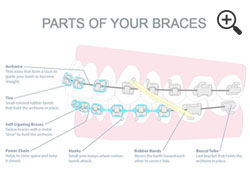Orthodontics is a specialty discipline of dentistry that focuses on alignment of the teeth and jaws to improve a person's smile and oral health.

The most common fixed appliances, braces consist of bands, wires and/or brackets. Bands are fixed around the teeth or tooth and used as anchors for the appliance, while brackets are most often bonded to the front of the tooth. Arch wires are passed through the brackets and attached to the bands. Tightening the arch wire puts tension on the teeth, gradually moving them to their proper position. Braces are usually adjusted monthly to bring about the desired results, which may be achieved within a few months to a few years.
Today's braces are smaller, lighter and show far less metal than in the past. They come in bright colors for kids as well as clear styles preferred by many adults.
Metal braces(traditional) are the most common type of braces use for orthodontic patients. They are more effective in treating extreme overcrowding than other options like clear braces or aligners and are less expensive.
However, the main disadvantage of traditional braces is the metal mouth appearance.
Self-ligating metal braces
There is no functional need for a module as the archwire is held into the brace with the addition of a metal clip or gate. Negating the use of modules means that there is less material for plaque/debris to potentially collect around the teeth. This in turn allows for better cleanability of the teeth and braces.
Conventional metal braces
The brackets are bonded onto the outer surface of the tooth and rely on a little colored/transparent elastic band called a module to hold the archwire into the brace.
Together, the brace/module/archwire complex allows the moving of the tooth into a more desired position.